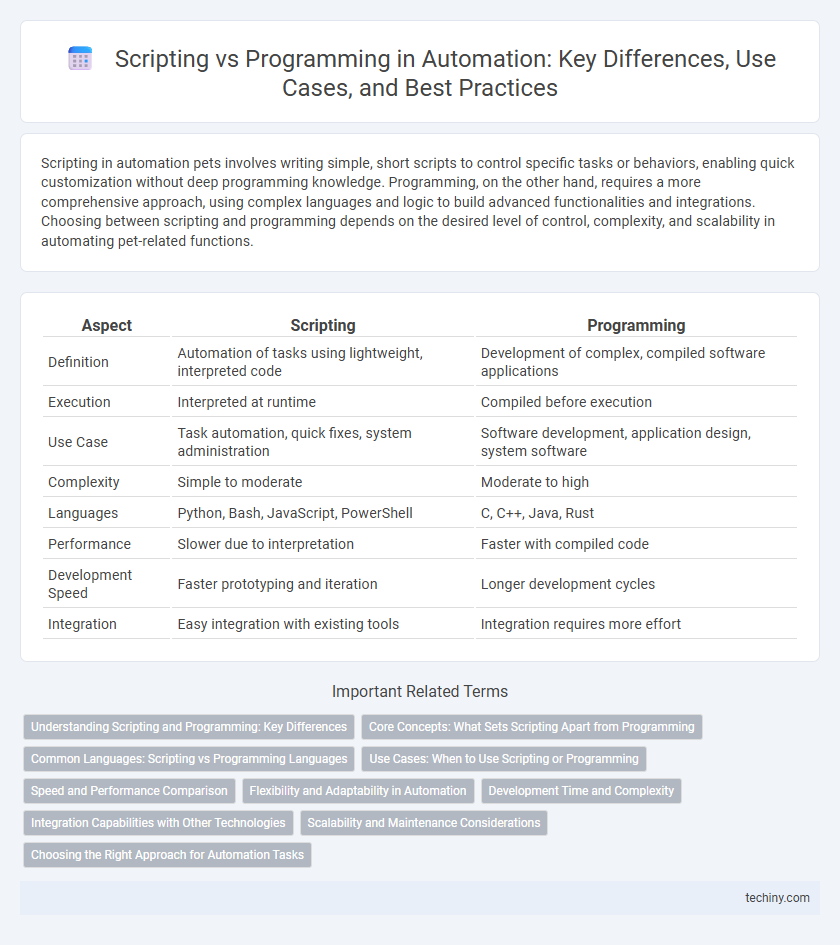Scripting in automation pets involves writing simple, short scripts to control specific tasks or behaviors, enabling quick customization without deep programming knowledge. Programming, on the other hand, requires a more comprehensive approach, using complex languages and logic to build advanced functionalities and integrations. Choosing between scripting and programming depends on the desired level of control, complexity, and scalability in automating pet-related functions.
Table of Comparison
| Aspect | Scripting | Programming |
|---|---|---|
| Definition | Automation of tasks using lightweight, interpreted code | Development of complex, compiled software applications |
| Execution | Interpreted at runtime | Compiled before execution |
| Use Case | Task automation, quick fixes, system administration | Software development, application design, system software |
| Complexity | Simple to moderate | Moderate to high |
| Languages | Python, Bash, JavaScript, PowerShell | C, C++, Java, Rust |
| Performance | Slower due to interpretation | Faster with compiled code |
| Development Speed | Faster prototyping and iteration | Longer development cycles |
| Integration | Easy integration with existing tools | Integration requires more effort |
Understanding Scripting and Programming: Key Differences
Scripting involves writing lightweight, high-level code to automate repetitive tasks and manipulate existing systems or software, typically executed line-by-line without the need for compilation. Programming, in contrast, encompasses developing comprehensive software applications with complex logic, requiring compilation or interpretation before execution. Key differences include execution speed, complexity, use cases, and the need for compilation, with scripting emphasizing ease of automation and programming focusing on robustness and scalability.
Core Concepts: What Sets Scripting Apart from Programming
Scripting involves writing smaller, task-specific code that automates repetitive actions or manages system processes, often interpreted and executed line-by-line, whereas programming entails developing comprehensive software applications with compiled code and complex logic structures. Core concepts that set scripting apart from programming include the emphasis on rapid development, ease of modification, and integration with existing systems without the need for compilation. Scripting languages such as Python, JavaScript, and Bash excel in automation workflows, while programming languages like C++, Java, and C# are designed for building scalable, performance-intensive applications.
Common Languages: Scripting vs Programming Languages
Scripting languages like Python, JavaScript, and Bash excel in automation tasks by enabling quick code execution and easy integration with system commands. Programming languages such as Java, C++, and C# offer robust features for building complex applications with greater control over memory and performance. The choice between scripting and programming languages depends on project requirements, balancing rapid development and system-level functionality.
Use Cases: When to Use Scripting or Programming
Scripting is ideal for automating repetitive tasks, managing system operations, and performing quick data manipulation due to its ease of use and faster execution. Programming is best suited for developing complex applications, building scalable software systems, and implementing intricate algorithms that require extensive control over hardware and software resources. Choosing between scripting and programming depends on the task's complexity, performance requirements, and the need for maintainability and scalability.
Speed and Performance Comparison
Scripting languages typically offer faster development cycles due to simpler syntax and dynamic typing, enabling rapid automation of repetitive tasks. In contrast, programming languages generally provide better runtime performance and optimization capabilities through compiled code and static typing. For automation scenarios requiring high-speed execution and resource efficiency, programming languages often outperform scripting counterparts, while scripting excels in quick prototyping and flexible task automation.
Flexibility and Adaptability in Automation
Scripting offers high flexibility in automation by enabling rapid development and easy modification of tasks, ideal for specific, repetitive workflows. Programming provides greater adaptability through comprehensive control structures and complex logic, supporting scalable and maintainable automation solutions across diverse environments. Combining scripting and programming techniques maximizes automation efficiency, balancing quick customization with robust, long-term adaptability.
Development Time and Complexity
Scripting typically requires less development time due to its interpreted nature and simpler syntax, making it ideal for automating small tasks and rapid prototyping. Programming involves compiling code, which increases development complexity but offers more control, scalability, and performance optimization for large-scale automation projects. Choosing between scripting and programming depends on the automation scope, with scripting favoring quick deployment and programming supporting complex, long-term automation solutions.
Integration Capabilities with Other Technologies
Scripting excels in rapid automation by seamlessly integrating with existing software tools and APIs, enabling efficient task execution without the need for compilation. Programming offers deeper integration capabilities through comprehensive libraries and frameworks, supporting complex systems and custom application development across various platforms. Both approaches enhance automation workflows by bridging technologies, but programming delivers greater scalability and robustness for enterprise-level integration.
Scalability and Maintenance Considerations
Scripting is typically suited for automating simple, repetitive tasks with quick implementation but may face limitations in scalability and long-term maintenance. Programming, with structured code and modular design, supports scalable solutions that can handle increasing complexity and ongoing updates more efficiently. Choosing between scripting and programming depends on the project's scope, with programming offering better maintainability for large-scale automation systems.
Choosing the Right Approach for Automation Tasks
Scripting excels at automating repetitive, simple tasks with quick development cycles, making it ideal for system administration and workflow automation. Programming is better suited for complex automation requiring scalability, error handling, and integration with diverse systems, often involving compiled languages like Python, Java, or C#. Selecting the right approach depends on factors such as task complexity, execution environment, and maintainability requirements.
Scripting vs Programming Infographic

 techiny.com
techiny.com